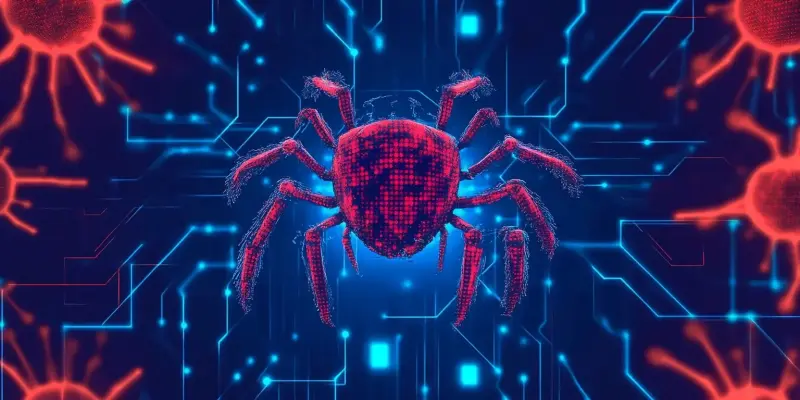In March, the cybersecurity world faced a major challenge with the discovery of the TookPS malware campaign, which utilizes advanced tactics to evade detection.This nefarious software exploits popular remote desktop applications and the DeepSeek LLM to infiltrate systems. The creators of TookPS have orchestrated a campaign that has spread through deceptive websites designed to mimic legitimate sources for Remote Desktop tools like UltraViewer, AutoCAD, and SketchUp, making it particularly difficult to trace and combat.
Intricacies of the TookPS Malware Campaign
Deceptive Distribution Techniques
The distribution strategy of TookPS malware is particularly insidious, relying on counterfeit websites that offer fake versions of widely-used software. Unsuspecting users trying to download recognized software such as Ableton or Quicken from these fraudulent sources inadvertently download the malware instead. Once on the victim’s device,TookPS communicates with command and control (C2) servers through domains registered early in the previous year. These servers send base64-encoded PowerShell scripts that allow persistent access and control over the compromised systems.
The multi-stage infection process begins with an initial breach, followed by the execution of three distinct PowerShell scripts. These scripts download Secure Shell (SSH) components and establish a covert SSH tunnel between the victim’s device and the attacker’s server.This tunnel provides attackers with the ability to execute arbitrary commands, maintain access, and manipulate the infected device remotely. The intricacy of this process demonstrates high levels of sophistication that make TookPS particularly challenging to detect and eliminate.
Maintaining Persistent Access
Another critical aspect of the TookPS malware’s modus operandi is its use of backdoors such as a modified version of Backdoor.Win32.TeviRat.This variant employs DLL sideloading techniques to compromise TeamViewer software, furthering attackers’ goals of maintaining persistent and covert access while evading detection mechanisms. By targeting trustworthy applications like TeamViewer, the malware ingeniously masks its activities as legitimate, routine operations.The stealthy nature of these techniques underscores the need for robust and advanced cybersecurity measures. Traditional detection methods often fail to identify such malware due to its discreet operation methods and deep integration within recognized software. As a result, TookPS has managed to pose a significant threat to individual and organizational cybersecurity infrastructures, emphasizing the evolving nature of cyber threats.
Expansion of Attack Vectors
Evolution of Threat Tactics
The TookPS campaign has demonstrated a remarkable ability to evolve and expand its attack vectors, ensuring sustained infection rates across varied targets.Cybersecurity experts have identified an increasing sophistication in the methods employed by threat actors associated with the TookPS malware. These actors continually adapt their strategies, leveraging new technologies and exploiting vulnerabilities in widely used software to reach a broader range of victims.This evolution in threat tactics highlights the importance of continuous advancements in cybersecurity defense mechanisms. Organizations must stay ahead of such developments by implementing comprehensive security measures, including rigorous monitoring, timely patching of software vulnerabilities, and employing sophisticated threat detection systems. Ongoing education of users about the risks of downloading software from unverified sources also plays a crucial role in mitigating attacks.
Implications for Cybersecurity
The TookPS malware’s broad and persistent attack vectors have significant implications for both users and cybersecurity professionals.As malware becomes more intricate and sophisticated, traditional antivirus and malware detection tools may find it increasingly difficult to keep pace. The campaign emphasizes the need for a multi-faceted approach to cybersecurity, drawing on threat intelligence, behavioral analysis, and cutting-edge technological solutions.
For individuals and organizations alike,the TookPS campaign underscores the imperative to prioritize cybersecurity. This includes regular updates and upgrades of security software, awareness training for employees, and investments in advanced threat detection and response systems. By understanding the sophisticated nature of modern malware campaigns, stakeholders can better prepare and defend against such threats, minimizing the potential for damage and disruption.
Future Considerations and Cybersecurity Practices
Enhanced Monitoring and Threat Intelligence
The emergence of TookPS malware necessitates a forward-looking approach to cybersecurity, focusing on advanced monitoring and threat intelligence.Continuous monitoring enables the early detection of suspicious activities, allowing for prompt action to mitigate potential threats. Leveraging threat intelligence provides insights into emerging trends and tactics employed by cybercriminals, equipping organizations with the knowledge to preemptively address vulnerabilities.
Furthermore, collaboration among cybersecurity experts, organizations, and government agencies is essential in staying ahead of sophisticated threats like TookPS.Sharing information about attack vectors and successful mitigation strategies can help create a more resilient cybersecurity ecosystem. Implementing a multi-layered security strategy, encompassing both proactive and reactive measures, is paramount in defending against evolving malware campaigns.
Robust Cybersecurity Measures
The TookPS malware campaign demonstrates the need for comprehensive and advanced cybersecurity measures.This malicious software targets popular remote desktop applications and cleverly uses the DeepSeek LLM to infiltrate systems. The developers behind TookPS have launched a campaign that disperses through deceptive websites made to look like legitimate sources for remote desktop tools such as UltraViewer, AutoCAD, and SketchUp. This makes it particularly challenging to trace and counteract.
TookPS’s advanced evasion techniques include mimicking legitimate software installation processes and disguising its communication with command-and-control servers.Once installed, the malware can silently harvest sensitive data, perform unauthorized activities, and compromise system integrity. The cybersecurity industry must stay vigilant and employ advanced detection measures to safeguard against threats like TookPS.Enhanced user awareness and regular updates to security protocols are essential in combating such sophisticated malware campaigns effectively.

